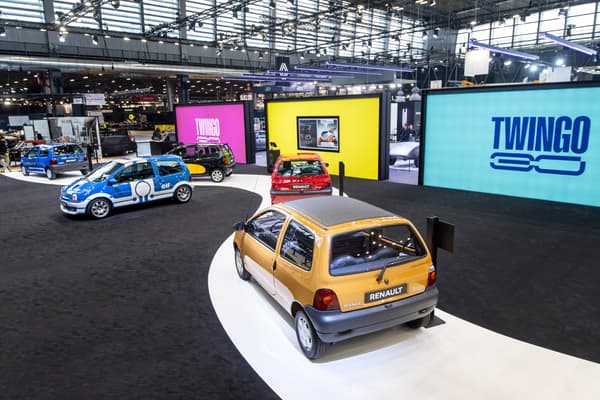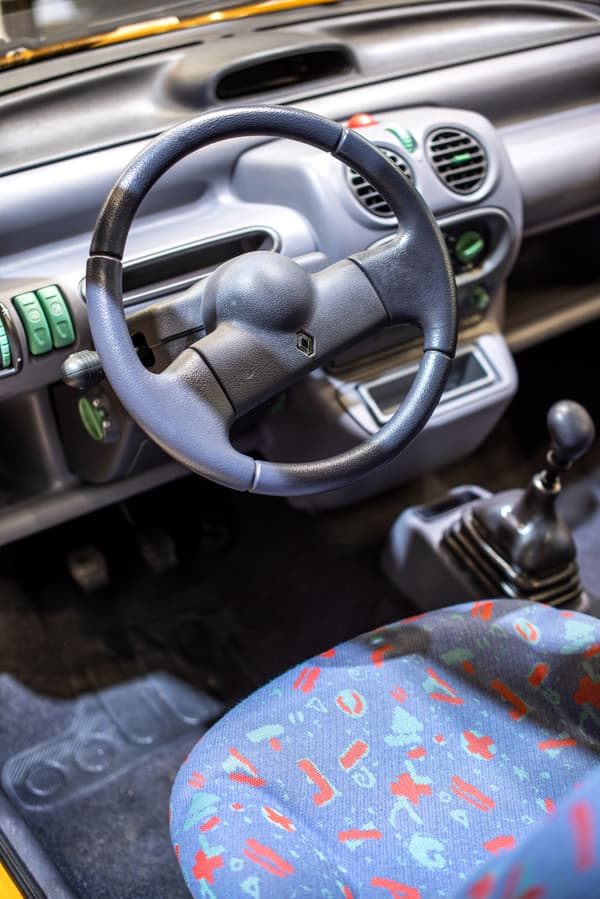After the Clio in 2020, it’s the Twingo’s turn to celebrate its 30th anniversary this year at the Retromobile show. The great meeting of more or less old cars has just opened its doors this Wednesday, February 1 at Paris-Porte de Versailles until next Sunday, the opportunity to immerse yourself in the history of one of the most famous tricolor automotive creations. . Bouille, which can now officially claim collector’s car status, for the first models released in 1993.
The Twingo, worthy heir of the 4L
The diamond brand’s stand thus celebrates the first generation of the Twingo, which began its commercial journey in February 1993, after a presentation at the 1992 Paris Motor Show.
“We tend to forget it, but the Twingo replaced the 4L, whose production ceased at the end of 1992 in France, after more than 30 years of existence.”recalls Hugues Portron, director of The Originals Renault (the new name for the diamond estate, until now “classic renault”)
For him, we find in the Twingo the philosophy of the 4L, unlike the R5, launched in the interval of 1972.
“There is a historian Jean-Louis Loubet who summed it up by saying that ‘4L was everyone’s car’: we make a car, with three versions, but very little diversity, it has to be liked by everyone, which ‘satisfies all needs. The R5 is the opposite, it is ‘everyone’s car’, we are going to invent the range in the range and it goes from the 5L to the 5 Turbo through the Alpine, the GTL, the TX, etc. This logic will continue between the R5 and the Clio, which came out in 1990, and Twingo will perpetuate this one-car-fits-all approach.”details director The Originals Renault.
An imagined car in… 1973
At its launch, the Twingo deliberately shows no diversity: the color is chosen from four and with only one option, the sunroof. “All interiors are the same, with one trim level, left hand drive only, no right hand drive for export”continues Hugues Portron.

A breakdown that we found in the oldest Twingo exhibited this year at Retromobile, a pre-series launched from the Flins factory in 1992, with small details different from the version that will go on sale a few months later. The opportunity to remember that the genesis of the project dates back to 1973, when the search began for the model that would succeed the 4L that had begun its journey in 1961. First objective: limit costs to offer an economic model.
“Renault was looking to follow the 4L in a program dubbed VBG, for ‘lower end vehicle’, shelved because the car was still too expensive to produce or they had pared everything down so much it was hideous.”specifies Hugues Portron.
Espace in a very compact version
But another model will finally revive the project in the 80s.
“In 1984, Renault launched another icon, the Espace, and finally the great idea, a little later, was to make a small monospace: apply the logic of the Espace to the entry level.”stresses our historian.
“We therefore have all the characteristics of the category, with a windshield in the continuation of the hood and the largest possible cabin in a vehicle of less than 3.50 meters, and modular with this famous sliding bench and the front seats that can be fully unfolded to form a bunk”adds Hugues Portron.
Renault would have gone so far in savings – in particular with an antenna housed in the rear-view mirror to limit the length of the cable connecting it to the car radio – that the urban minivan will finally be able to afford a few “crazy things” for an entry-level model: a pantograph monoblade wiper, tinted windows or even rear window defroster.
An interior that is still modern today
The interior also recovers a very current element for the time: a central and digital counter. Behind the wheel, there’s just the light display. Other striking elements of the early Twingos, this steering wheel and the dashboard have been pushed as far forward as possible to increase the space on board or even the warning button in the shape of a clown’s nose that crowns a highly refined dashboard.
The colorful seats also participate in this very 90s spirit: there is no option at this level and therefore a design that must stick to all body colors, hence this color patchword.

“There was also the idea of making people forget that we were in a car that was intended to be very affordable, especially compared to its competitors of the time such as the Fiat Panda and Ford Fiesta.”emphasizes Hugues Portron.
To be specific, the Twingo was launched in 1993 at a starting price of 55,000 francs, which is slightly less than the current 13,000 euros taking inflation into account. The current budget to afford a Dacia Sandero with a few options. The Dacia Sandero is ultimately the vehicle that replaced the 4L and Twingo to embody the entry level of the Renault group.
Collections, as in fashion
When the Twingo was launched, the success was immediate. The city then faces a new challenge: constantly renewing itself to generate change, without altering its entry-level positioning.
It is clear that the Twingo will change little: we recognize the models of the first years by the indicators separated from the lights or the shields that were not yet on its body. But Renault will innovate by offering collections, as in fashion, by introducing new colors. There will be seven in fifteen years and three renovations, in 1998, 2000 and 2004.
“One of Twingo’s mottos was ‘it’s up to you to invent the life that goes with it’ and that’s some of what we find in this diversity that will follow his early career.”
The Twingo also had the right to special series, of which you can discover some examples at Retromobile, such as the one designed by the high-end car specialist Lecoq in 1995, with less than fifty copies produced. An ultra-luxury Twingo treated like a Bugatti, whose design on the sides and design of the tires takes it up. Or the one from Benetton, dating from 1996, with a very colorful fabric on the inside. There are more than 60 throughout the Twingo’s entire career, the first of the name.
In total, this first generation Twingo sold 2.6 million units, mainly produced in Flins (Yvelines), but also at the Valladolid plant in Spain, allowing Renault to respond to strong demand. A success mainly in France, but also in some European markets and around the world, with production in Colombia and Uruguay for South America.
Source: BFM TV

